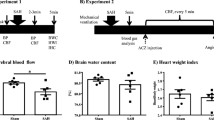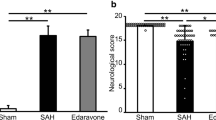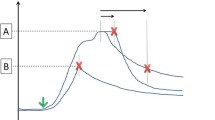Abstract
Introduction
Cerebral vasospasm (CVS) after subarachnoid hemorrhage (SAH) often leads to poor outcomes in SAH patients. Overexpression of endothelin-1 (ET-1) could contribute to the development of CVS. The purpose of this study was to investigate cerebral microcirculation by whole-brain perfusion CT scan and ET-1 expression following SAH.
Methods
SAH was induced in rabbits. Cerebral blood flow (CBF), cerebral blood volume (CBV), time to peak (TTP), and mean transit time (MTT) were measured with CT perfusion techniques at days 1, 4, 7, and 14 following SAH. Expression of ET-1 was determined by ELISA accordingly. Histological sections of the brain tissue were also examined.
Results
Whole-brain perfusion showed that CBV and TTP increased at day 4 and maintained elevated rate until day 14. MTT increased at day 4, peaked at day 7, and then decreased at day 14. CBV of the occipital lobe was greater than that in the frontal and parietal lobes at day 4. CBF of the occipital lobe increased significantly compared to that of other lobes at day 7. ET-1 expression in the SAH group was significantly greater than that in the control at various time points. Moreover, ET-1 levels were positively correlated with MTT value.
Conclusion
CTP detects changes in cerebral microcirculation following SAH. Microcirculation of each lobe was different and could be quantified to identify high-risk areas of cerebral ischemia. ET-1 expression was significantly increased and was correlated with MTT as well, suggesting that ET-1 influences cerebral microcirculation following SAH.







Similar content being viewed by others
References
Cenic A, Nabavi DG, Craen RA, Gelb AW, Lee TY (2001) A CT method to measure hemodynamics in brain tumors: validation and application of cerebral blood flow maps. AJNR Am J Neuroradiol 21:462–470
Wang XM (2004) Progress in neuroscience. In: John H. Zhang (ed) Experimental Therapies for SAH and Cerebral Vasospasm, 6th edn. Bei Jing, pp 635–645
Vajkoczy P, Horn P, Thome C, Munch E, Schmiedek P (2003) Regional cerebral blood flow monitoring in the diagnosis of delayed ischemia following aneurismal subarachnoid hemorrhage. J Neurosurg 98:1227–1234
Eskridge JM, McAuliffe W, Song JK, Eskridge JM, McAuliffe W, Song JK, Deliganis AV, Newell DW, Lewis DH, Mayberg MR, Winn HR (1998) Balloon angioplasty for the treatment of vasospasm: results of first 50 cases. Neurosurgery 42:510–517
Wintermark M, Dillon WP, Smith WS, Lau BC, Chaudhary S, Liu S, Yu M, Fitch M, Chien JD, Higashida RT, Ko NU (2008) Visual grading system for vasospasm based on perfusion CT imaging: comparisons with conventional angiography and quantitative perfusion CT. Cerebrovasc Dis 26:163–170
Mendrik AM, Vonken EP, de Kort GA, van Ginneken B, Smit EJ, Viergever MA, Prokop M (2012) Improved arterial visualization in cerebral CT perfusion-derived arteriograms compared with standard CT angiography: a visual assessment study. AJNR Am J Neuroradiol 33:2171–2177
Killeen RP, Mushlin AI, Johnson CE, Comunale JP, Tsiouris AJ, Delaney H, Dunning A, Sanelli PC (2011) Comparison of CT perfusion and digital subtraction angiography in the evaluation of delayed cerebral ischemia. Acad Radiol 18:1094–1100
Ohkita M, Tawa M, Kitada K, Matsumura Y (2012) Pathophysiological roles of endothelin receptors in cardiovascular diseases. J Pharmacol Sci 119:302–313
Kuruppu S, Chou SH, Feske SK, Suh S, Hanchapola I, Lo EH, Ning M, Smith AI (2014) Soluble and catalytically active endothelin converting enzyme-1 is present in cerebrospinal fluid of subarachnoid hemorrhage patients. Mol Cell Proteomics 13:1091–1094
Spallone A, Pastore FS (1989) Cerebral vasospasm in a double-injection model in rabbit. Surg Neurol 32:408–417
Liu-Deryke X, Rhoney DH (2006) Cerebral vasospasm after aneurismal subarachnoid hemorrhage: an overview of pharmacologic management. Pharmacotherapy 26:182–203
Macdonald RL, Weir BK (1991) A review of hemoglobin and the pathogenesis of cerebral vasospasm. Stroke 22:971–982
Suarez JI, Tarr RW, Selman WR (2006) Aneurysmal subarachnoid hemorrhage. N Engl J Med 354:387–396
Molyneux AJ, Kerr RS, Yu LM, Clarke M, Sneade M, Yarnold JA, Sandercock P; International Subarachnoid Aneurysm Trial (ISAT) Collaborative Group (2005) International subarachnoid aneurysm trial (ISAT) of neurosurgical clipping versus endovascular coiling in 2143 patients with ruptured intracranial aneurysms: a randomised comparison of effects on survival, dependency, seizures, rebleeding, subgroups, and aneurysm occlusion. Lancet 366:809–817
Naidech AM, Janjua N, Kreiter KT, Ostapkovich ND, Fitzsimmons BF, Parra A, Commichau C, Connolly ES, Mayer SA (2005) Predictors and impact of aneurysm rebleeding after subarachnoid hemorrhage. Arch Neurol 62:410–416
Matsuo F, Ajax ET (1979) Palatal myoclonus and denervation super sensitivity in the central nervous system. Ann Neurol 5:72–78
Miles KA, Hayball MP, Dixon AK (1993) Functional images of hepatic perfusion obtained with dynamic CT. Radiology 188:405–411
Laslo AM, Eastwood JD, Pakkiri P, Chen F, Lee TY (2008) CT perfusion-derived mean transit time predicts early mortality and delayed vasospasm after experimental subarachnoid hemorrhage. AJNR Am J Neuroradiol 29:79–85
Sun L, Zhang W, Wang X, Song J, Li M (2012) Inhibition of protein kinase C signal reduces ET receptor expression and basilar vasospasm after subarachnoid hemorrhage in rats. J Integr Neurosci 11:439–451
Dudhani RV, Kyle M, Dedeo C, Riordan M, Deshaies EM (2013) A low mortality rat model to assess delayed cerebral vasospasm after experimental subarachnoid hemorrhage. J Vis Exp. e4157
Stein SC, Levine JM, Nagpal S, LeRoux PD (2006) Vasospasm as the sole cause of cerebral ischemia: how strong is the evidence? Neurosurg Focus 21:E2
Takagi R, Hayashi H, Kobayashi H, Kumazaki T, Isayama K, Ikeda Y, Teramoto A (1998) Three- dimensional CT angiography of intracranial vasospasm following subarachnoid hemorrhage. Neuroradiology 40:631–635
Anderson GB, Ashforth R, Steinke DE, Findlay JM (2000) CT angiography for the detection of cerebral vasospasm in patients with acute subarachnoid hemorrhage. AJNR Am J Neuroradiol 21:1011–1015
Joo SP, Kim TS, Kim YS, Moon KS, Lee JK, Kim JH, Kim SH (2006) Clinical utility of multislice computed tomographic angiography for detection of cerebral vasospasm in acute subarachnoid hemorrhage. Minim Invasive Neurosurg 49:286–290
Baldwin ME, Macdonald RL, Huo D, Novakovic RL, Goldenberg FD, Frank JI, Rosengart AJ (2004) Early vasospasm on admission angiography in patients with aneurysmal subarachnoid hemorrhage is a predictor for in-hospital complications and poor outcome. Stroke 35:2506–2511
Soehle M, Czosnyka M, Piekard JD, Kirkpatrick PJ (2004) Continuous assessment of cerebral autoregulation in subarachnoid hemorrhage. Anesth Analg 98:1133–1139
Cosention F, Katusic ZS (1994) Does endothelin-1 play a role in the pathogenesis of cerebral vasospasm? Stroke 25:904–908
Loesch A, Burnstock G (2002) Endothelin in human cerebrovascular nerves. Clin Sci (Lond) 103(Suppl 48):404S–407S
Masaoka H, Suzuki R, Hirata Y, Emori T, Marumo F, Hirakawa K (1989) Raised plasma endothelin in aneurismal subarachnoid haemorrhage. Lancet 2:1402
Wang ZP, Chen HS, Wang FX (2011) Influence of plasma and cerebrospinal fluid levels of endothelin-1 and NO in reducing cerebral vasospasm after subarachnoid hemorrhage during treatment with mild hypothermia, in a dog model. Cell Biochem Biophys 61:137–143
Coucha M, Li W, Ergul A (2012) The effect of endothelin receptor a antagonism on basilar artery endothelium-dependent relaxation after ischemic stroke. Life Sci 91:676–680
McMahon CJ, Hopkins S, Vail A, King AT, Smith D, Illingworth KJ, Clark S, Rothwell NJ, Tyrrell PJ (2013) Inflammation as a predictor for delayed cerebral ischemia after aneurysmal subarachnoid haemorrhage. J Neurointerv Surg 5:512–517
Acknowledgments
This work was supported by a grant from National Science Foundation of China (No: 81071151) to SBL.
Ethical standards and patient consent
We declare that this manuscript does not contain clinical studies or patient data. “Principles of laboratory animal care” (NIH publication No. 86–23, revised 1985) were followed, as well as the current version of Chinese Law on the Protection of Animals. All protocols were approved by the Institutional Animal Care and Use Committee (IACUC) of China Medical University.
Conflict of interest
We declare that we have no conflict of interest.
Author information
Authors and Affiliations
Corresponding author
Rights and permissions
About this article
Cite this article
Lei, Q., Li, S., Zheng, R. et al. Endothelin-1 expression and alterations of cerebral microcirculation after experimental subarachnoid hemorrhage. Neuroradiology 57, 63–70 (2015). https://doi.org/10.1007/s00234-014-1435-y
Received:
Accepted:
Published:
Issue Date:
DOI: https://doi.org/10.1007/s00234-014-1435-y




